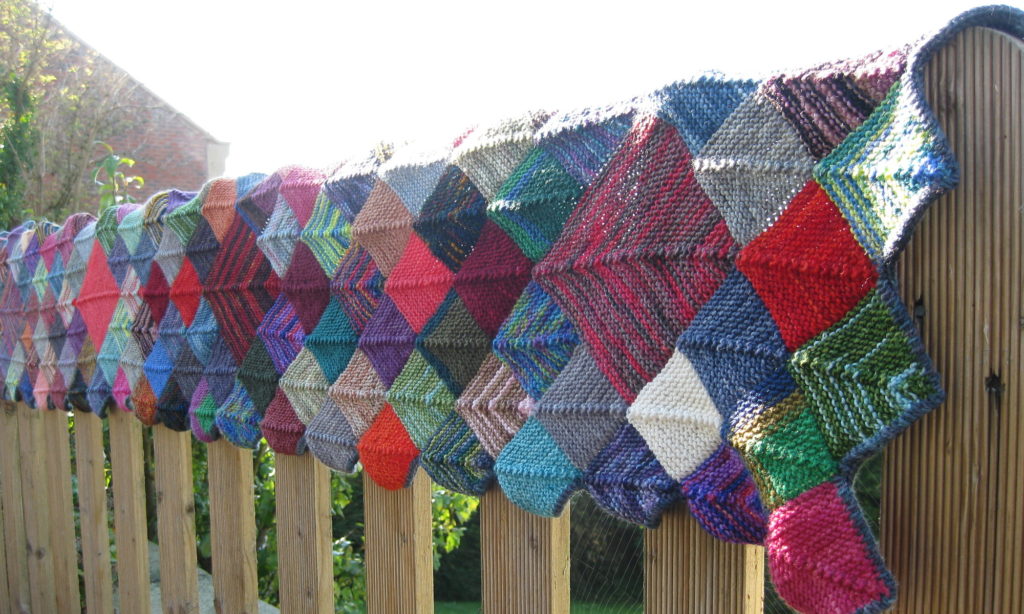Three buildings visited – or scroll right to the bottom for my reflections.
St Luke’s – the Bombed-Out Church
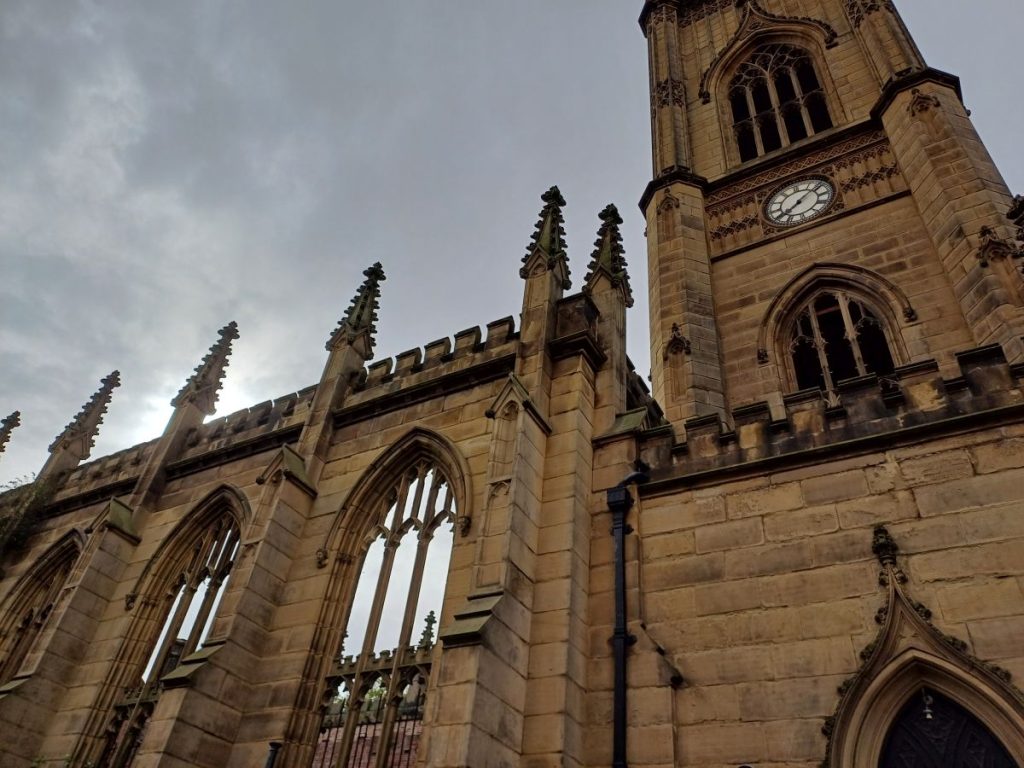
I was particularly interested to see this church building because of the parallels with our St Martin’s. St Luke’s was also bombed during the second world war, but has been treated differently. Rather than being partially restored, it has been left as a roofless ruin (officially, a redundant church), but the space has been re-purposed for community use with an emphasis on art and culture.
There are QR codes on all the entrance gates that lead you to their website, where you can read about their story and their current focus.
“Having become an established venue for theatre, dance, classical and world music, visual art, cinema, and spoken word, as well as alternate and participatory forms of work, the site now stands as a testament to community spirit and the power of the arts to affect change – a living, working monument to the people of Liverpool.
The ongoing story is one of hope and transformation.“
Liverpool Parish Church
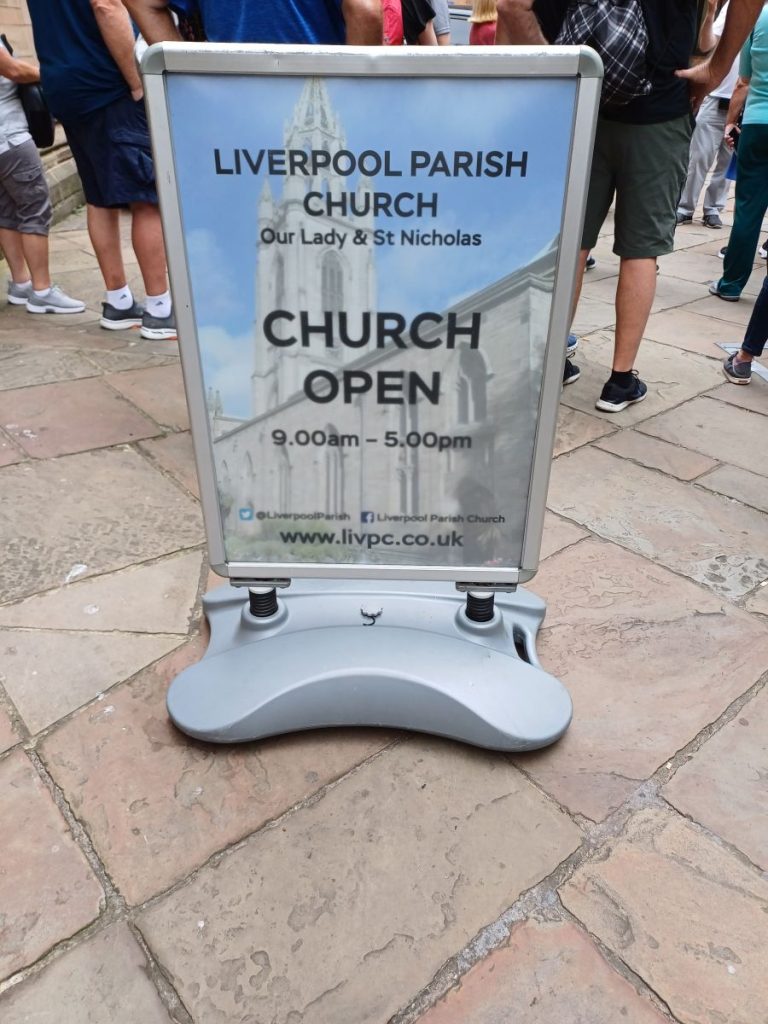
Liverpool Parish Church is a perfect example of the type of Church I am aiming to visit. It is very much aimed at the tourists visiting the docks area during the week. The building is open during the day and has been thoughtfully presented to be informative and interesting.
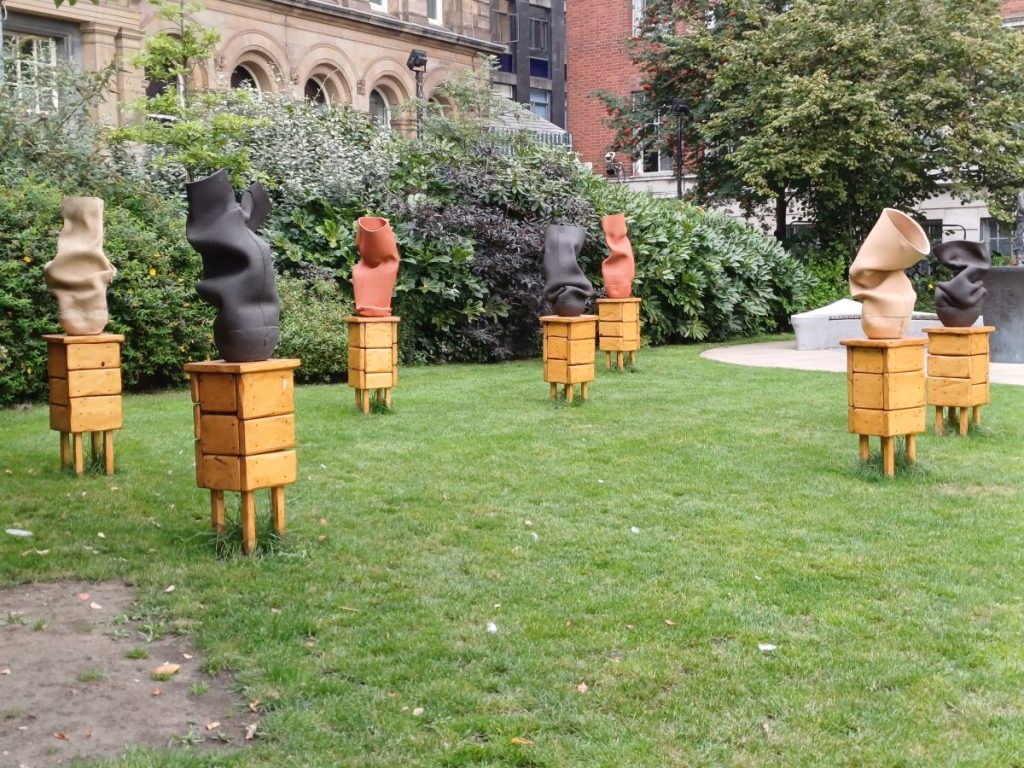
The churchyard has been landscaped into a series of formal garden areas, a mixture of art installation, planting and memorials to various naval and nautical events. The churchyard appears to be a very secular space – almost nothing to say it is attached to a church, with the exception of a crucifix.
A sign outside the church door invites visitors in. Once inside, there is an entrance-hall (narthex) which has a lot of visitor-focussed stuff. The first thing that I noticed was a 2 minute video that plays a welcome message from the Rector and shows some adverts for parish events. The video describes worship, ministry and outreach and invites visitors “to explore, to visit, to light a candle, to say a prayer”. I find it really interesting that there is no direct mention of Christianity, God or Jesus, or even the Church of England. The video mentions the Eucharist and worship without saying anything about what they are.
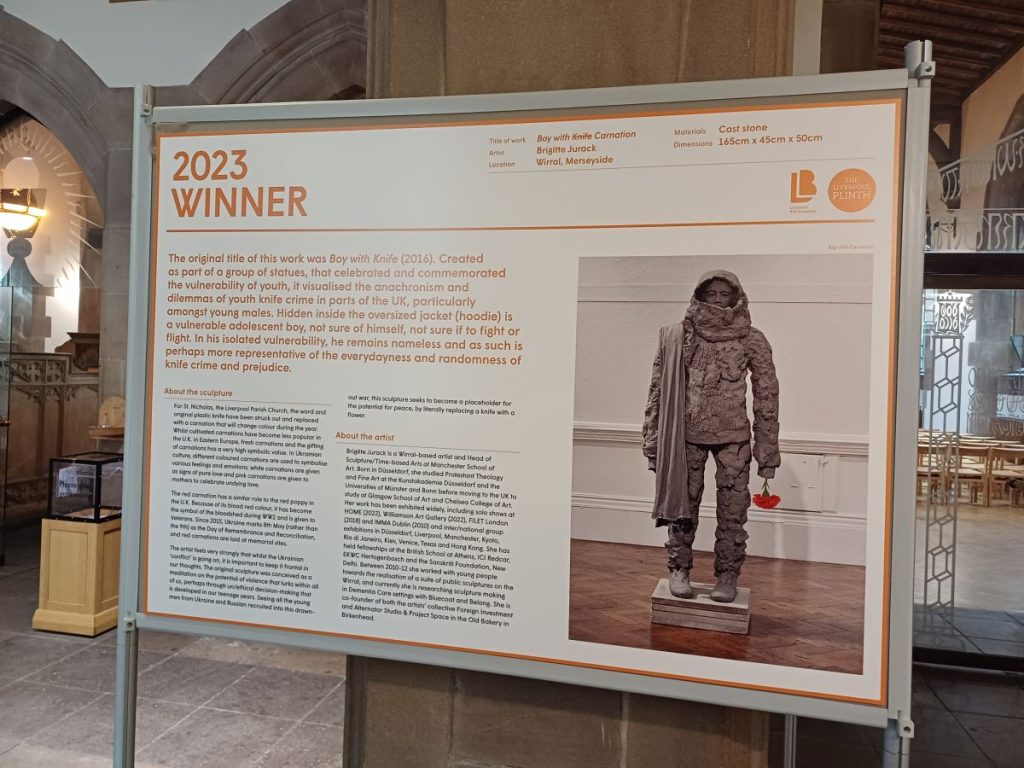
In the middle of the entrance hall is a 4-panel explanation of an art contest. The winning entry each year is placed on a plinth outside the building. Round the outside of the entrance-hall is a history of the parish. This begins with the foundation of the first church on the site and details the changes in architecture and politics that have impacted the parish, plus notable people associated with the parish. There is an emphasis on ministry to the city, from the provision of aid to the poor to work with seafarers and various institutions in the city. There is no indication at any point of why this happens or how it relates to Christianity.
Inside the main part of the church building, there is a wonderful atmosphere of peace. Several people were in the building just sitting and praying, others were walking around.
At various points around the building, there are small (A4) notices with brief explanations of the signficance of parts of the church and indications of how to find out more.
- Font – “This is where we begin our Christian journey. In our broken world we are washed clean with the waters of Baptism (also known as Christening), and we enter into new life with Jesus Christ. Find out more about Christianity by scanning the QR code on the right. For more information on getting baptised at Liverpool Parish Church please visit our website.”
- Organ – “In the Bible we hear that Jesus’ disciples sang songs (Matthew 26:30). Hymns and music remain central to Christian worship today. Our pipe organ, built in 1952, is played from here, but the sound comes from the pipes above your head. Find out more about Music at Liverpool Parish Church by scanning the QR code”…
- Ambo (N.B. I’d call this a lectern) “This is where we read from the bible and hear the story of our faith. It is also our pulpit, where we preach to the congregation, interpreting the Word of God which guides us in our Christian Lives. Find out more about Christianity by scanning the QR code”…
- Altar – “This is where we celebrate the Eucharist (also known as Mass or Holy Communion). Before he died, Jesus took bread and wine and said ‘This is my body‘ and ‘This is my blood‘. In the sacrament of the Eucharist we become one with him and with each other. Find out more about Christianity by scanning the QR code”… “The Eucharist is celebrated every day at Liverpool Parish Church. For service times please visit our website…”
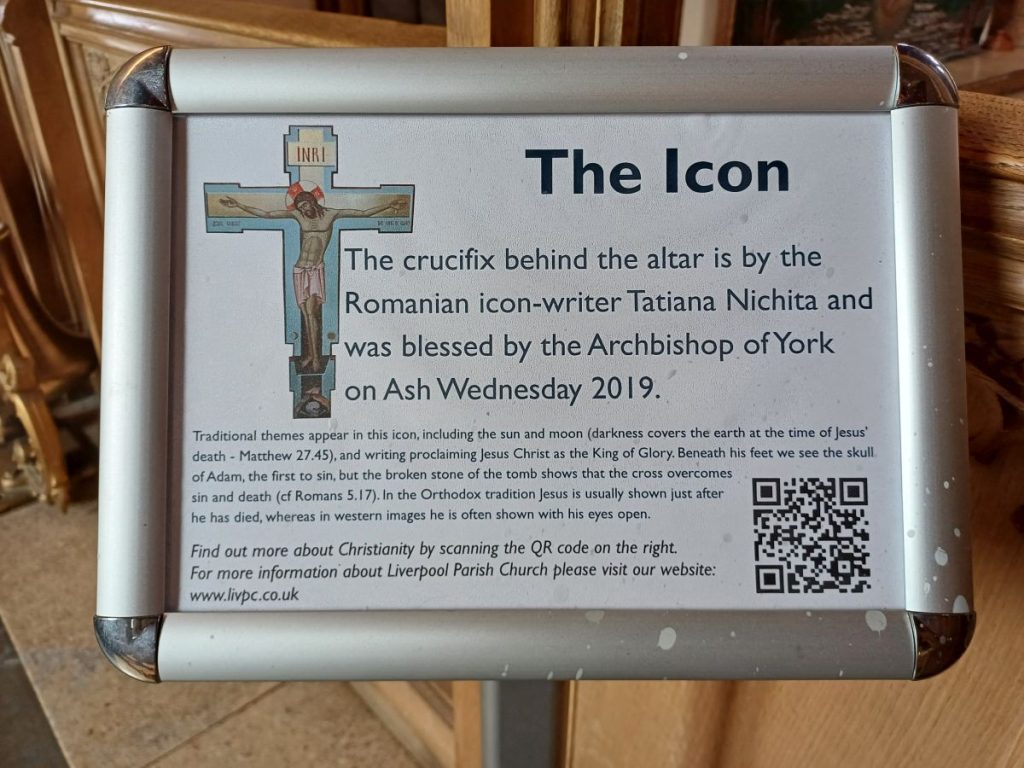
- Icon – “The crucifix behind the altar is by the Romanian icon-writer Tatiana Nichita and was blessed by the Archbishop of York on Ash Wednesday 2019. Traditional themes appear in this icon, including the sun and moon (darkness covers the earth at the time of Jesus’ death – Matthew 27.45) and writing proclaiming Jesus Christ as the King of Glory. Beneath his feet we see the skull of Adam, the first to sin, but the broken stone of the tomb shows that the cross overcomes sin and death (cf Romans 5:17). In the Orthodox tradition Jesus is usually shown just after he has died, whereas in Western images he is often shown with his eyes open. Find out more about Christianity by scanning the QR code”…
Most of these notices have links to a page on the parish website that has an introduction to Christianity. The notice on the organ links to the monthly music list.
The “What we believe” page gives an interesting insight into the theological point of view of the church. The most surprising thing to me is that the introductory paragraph “What is a Christian” doesn’t actually mention Jesus Christ, being focussed solely on the relationship of the Christian to God and other human beings. Reassuringly, Jesus does get more than a passing mention on the rest of the page.
After the introduction comes a surprising statement “you have probably participated in all of these marks of Christianity already”. Given that the marks of Christianity that were mentioned are prayer, worship, service and the sacraments, I’m not sure where you could possibly find the evidence to support this. Can we really assume that the average visitor has participated in the sacraments? Perhaps, prayer, worship and service are more likely to be a part of the average person’s life, but I still think this is a bit optimistic.
What’s missing?
I found it puzzling that there were a couple of really fascinating aspects of the church building that were not mentioned or explained at all. This may be because I am not your typical tourist and what I’m looking for is not what your average visitor would be looking for.
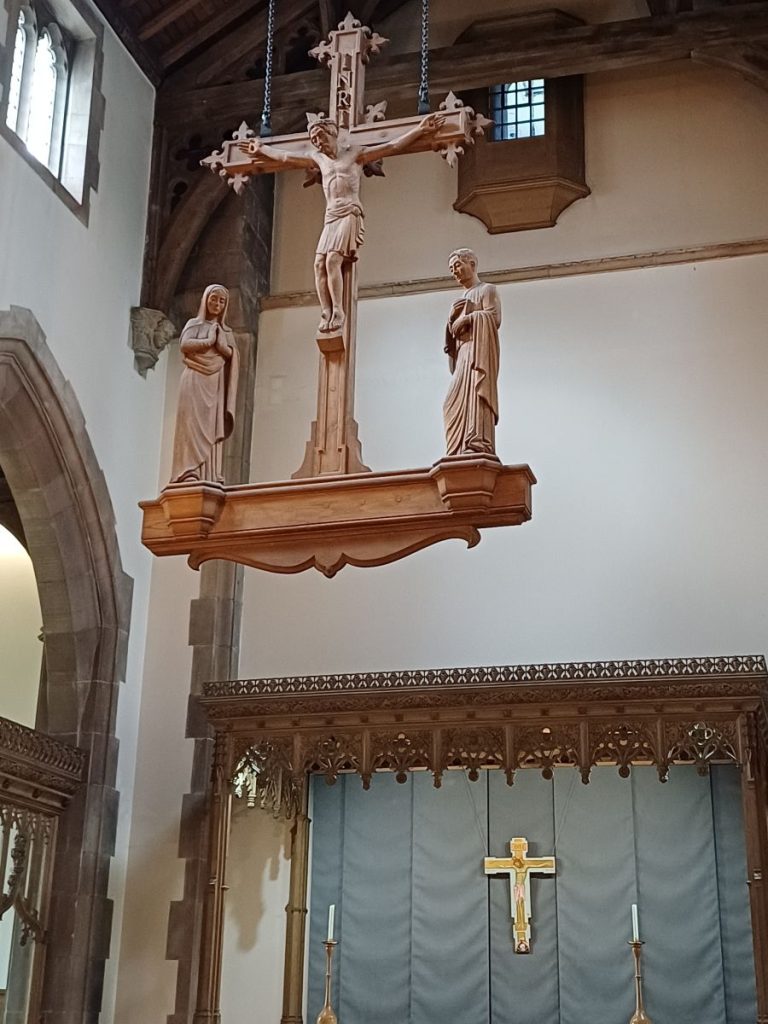
Over the sanctuary area of the church is a magnificent rood, carved from wood, showing Christ on the cross with his mother and John the apostle. The welcome leaflet explains that it is the shape of an anchor, but there is no indication in the building itself about its significance.
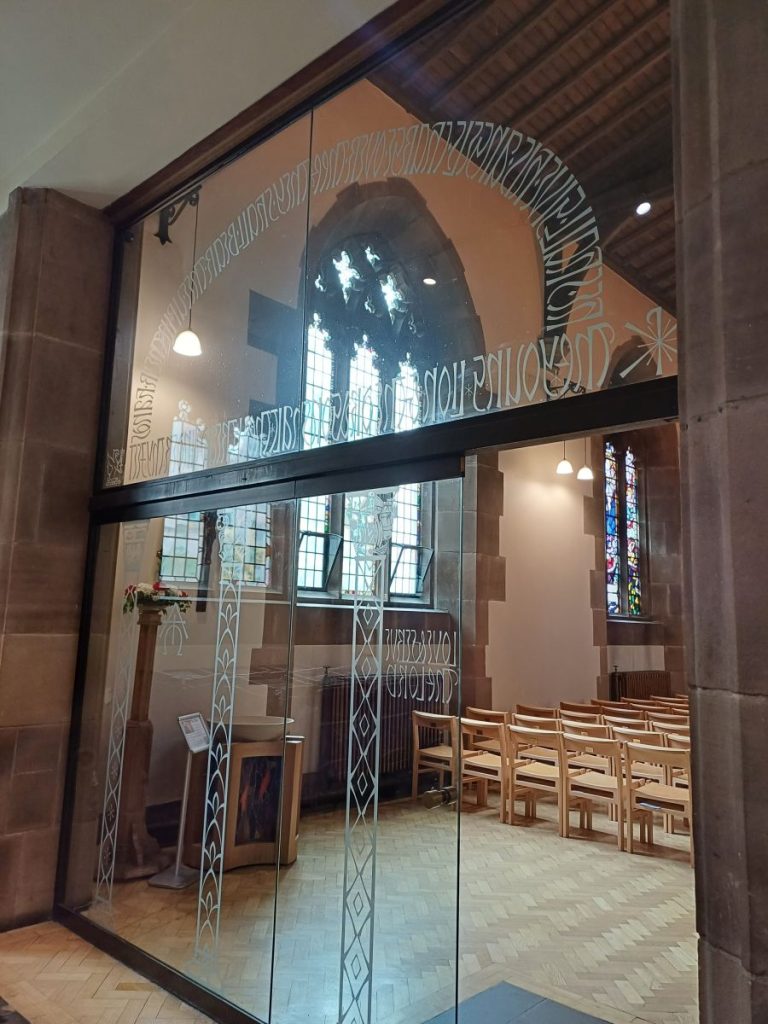
Between the narthex and the worship space, are large glass doors etched with passages from scripture. Some of them can be read from outside and some from inside. The font used for the writing is quite ornate and tricky to read, especially where the light is shining through. I would love to have had some links to the biblical references and why they were chosen or why they were important. I haven’t been able to find this information anywhere.
Liverpool Anglican Cathedral
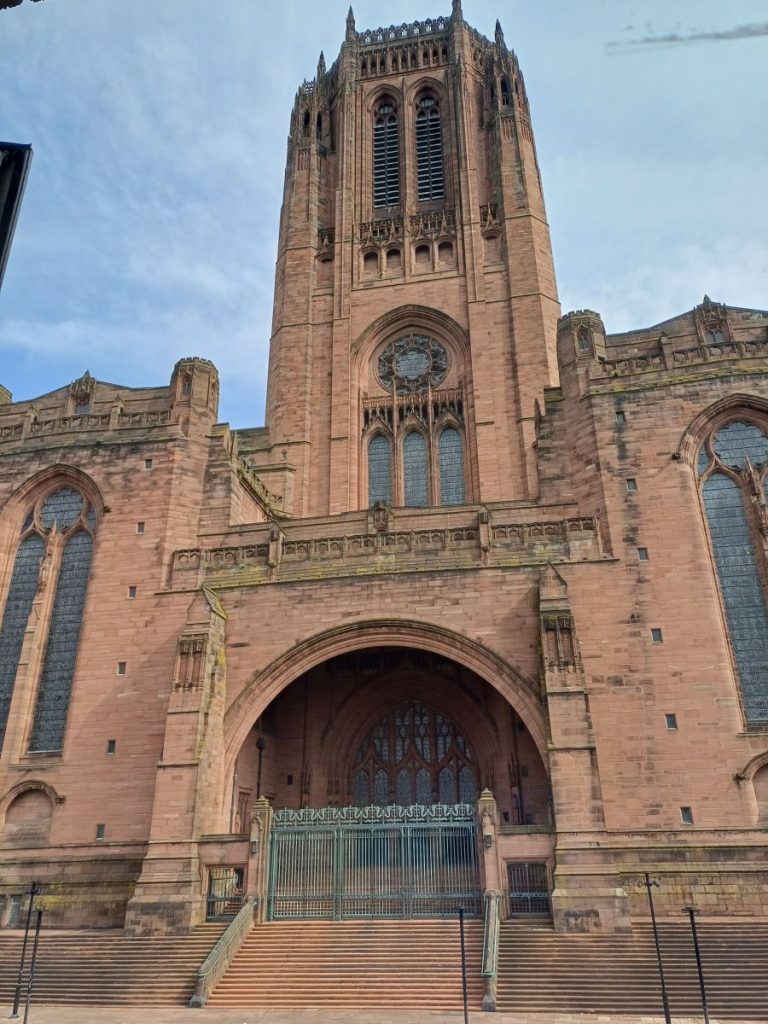
I should probably mention that I was staying with one of the residentiary canons of the cathedral, so this may not be a completely neutral write-up.
The visitor entrance is a side door, opening out into a long, blank, corridor with a welcome desk at the end. Obviously, as a staffed building, the experience of visiting is different to a parish church. As I passed the welcome desk, I picked up a trifold leaflet (available in many languages – I went for English).
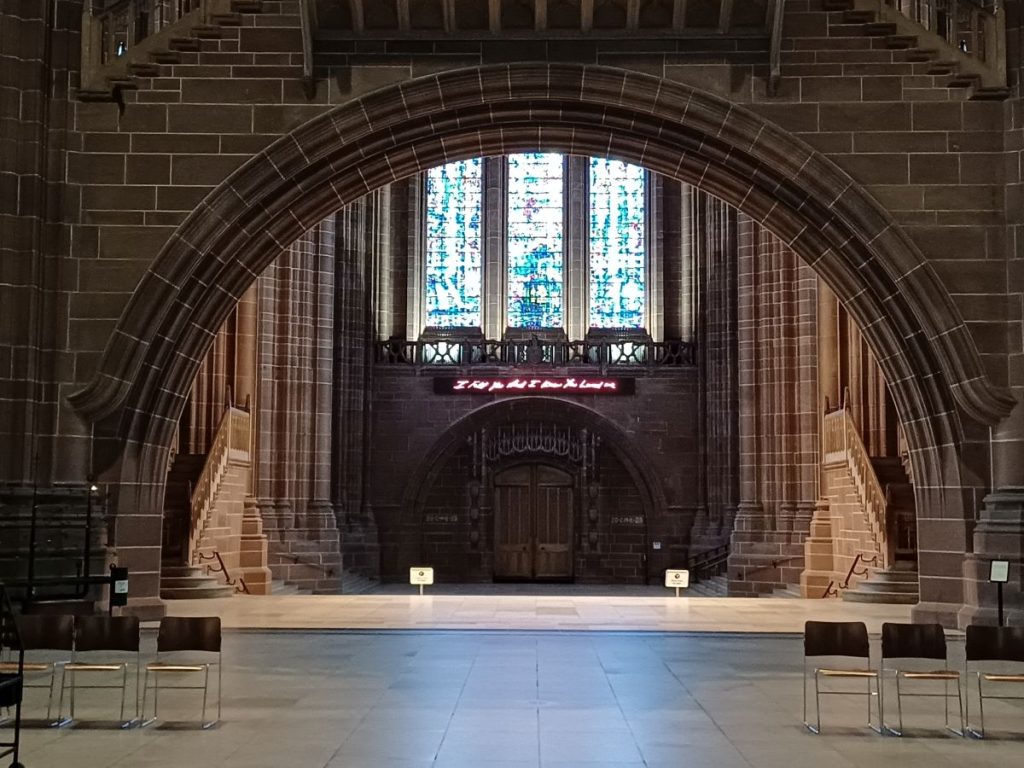
The cathedral’s tagline is “built by the people, for the people to the Glory of God”. This emphasis on the cathedral belonging to the people of Liverpool continues throughout the building. It is clear that, no matter what is happening in the building, the main purpose is for Christian worship.
One of the sections of the leaflet suggests visiting the baptistry so you can “trace the line from Jesus of Nazareth to a Christian Cathedral in six steps”. Sure enough, there are six panels:
- Who is Jesus?
- What is a Christian?
- What is The Church?
- What is the Church of England?
- What is a diocese and Cathedral?
- Liverpool Cathedral
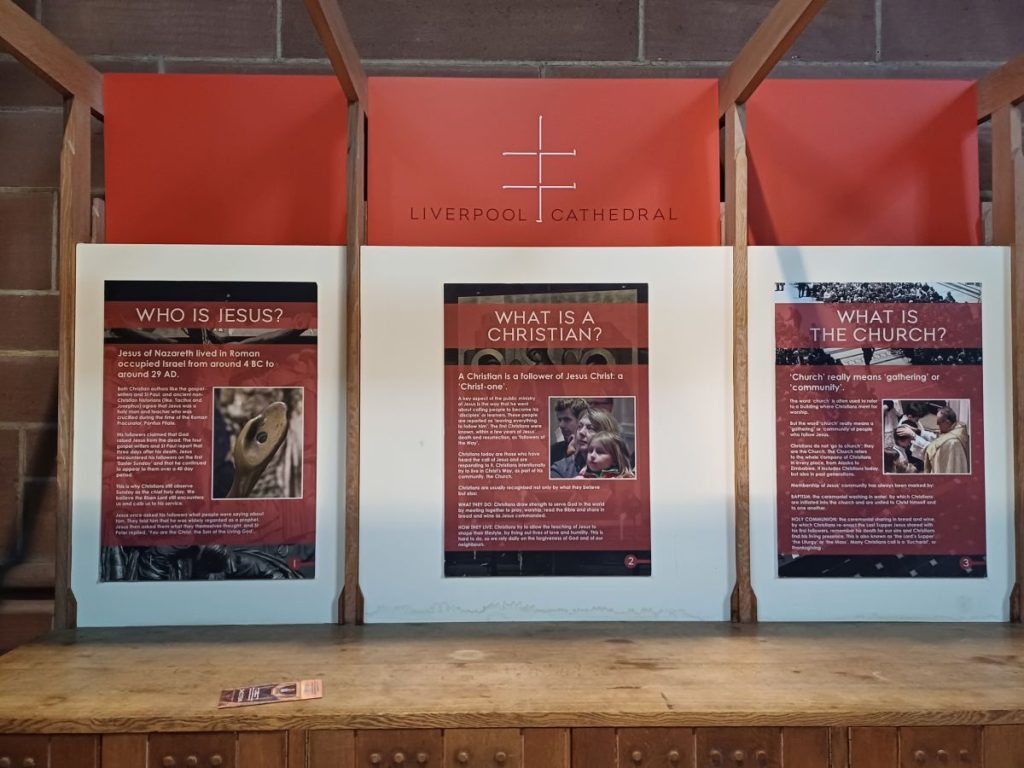
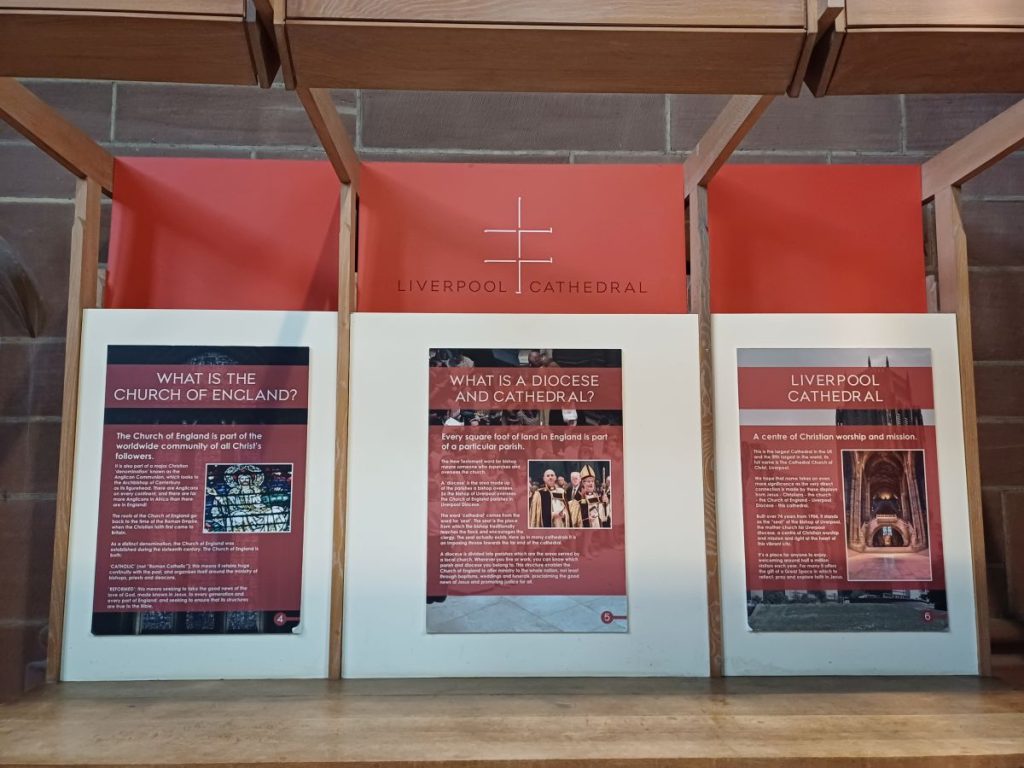
I love the simplicity and story of this. It takes you on a journey from Jesus walking on the Earth to you standing in the Cathedral, mentioning the main features of Christian life and explaining some key terms along the way.
The big question for me about this is why these panels are not the first things you see.
Dotted around the cathedral, there are a selection of small posters in a very similar format to those in Liverpool Parish Church. A4 size, mounted in free-standing frames
- Font – “At the font, we encounter God’s invitation to follow Jesus. People of all ages are baptised (or “christened”) with water as a sign of their commitment to Christ and membership of his Church. Jesus chose to be baptised and set the example for all his followers to be baptised. Many people have been baptised in this Cathedral and have started their new lives in Christ. We are still baptising people and welcoming them into God’s family today!”
- Ambo – “At the Ambo, we encounter the Word of God read out loud for all to hear. From the earliest days of Christianity, most churches had a raised platform or lectern from which the Bible was read. Our Christian holy book is split into two sections, the Old Testament (before Christ) and New Testament (introducing Jesus , and what happened next). One of the most important features of all Christian worship is the reading aloud of passages from Holy Scripture. It is at the very heart of every service that takes place in the Cathedral, and the basis for all our preaching and teaching. ”
- Icon of the Trinity – “This depiction of a famous icon helps us to encounter God as the Holy Trinity: Father, Son and Holy Spirit. It is a mystery how one God can have three ‘personalities’ but that is what emerges as we read the Bible. The icon shows the three ‘persons’ in a circle of beautiful fellowship. It is not only two-dimensional. Rather, the Trinity reaches out of the picture to invite us in and embrace us. The God who knows us and loves us invites us to encounter his love!”
- High Altar – “At the Lord’s Table or Altar, we encounter the transforming presence and grace of Jesus tangibly as we celebrate the Holy Communion or Eucharist. This is the special meal of the Christian community and it is celebrated in this Cathedral every day. Here are placed the bread and the wine, recalling the night before Jesus died when he shared bread and wine with his followers. He told them that the broken bread was his body and the wine was his blood shed for them. He commanded them to continue to remember his death and rising again by breaking bread and sharing wine regularly together.”
- Dulverton Bridge “Originally built for part of the organ, this unique Bridge provides an amazing vantage point up and down the building. Jesus, on the Cross, became that special bridge between God and humanity. Beyond the bridge is visible, in neon lights, a striking piece of artwork by renowned artist, Tracey Emin. It reminds us of our Cathedral vision that everyone who comes here will encounter the God who knows them and loves them.”
- Children’s Chapel – “In this Chapel, we can encounter the special love of God for all children, especially the most vulnerable. Jesus famously said ‘Let the little children come to me, and do not hinder them, for the kingdom of heaven belongs to such as these.’ The statue depicts Joseph, the husband of Mary, who shared in raising the child Jesus. Please use this space to pray for children worldwide, our schools and families, and for all those who have been particularly affected by the loss of a child.”
- Celebrating women (this poster was in the Lady Chapel) – “The Lady Chapel, as well as being dedicated in honour of Mary, the Mother of Jesus, also celebrates the work of many godly women through the centuries. Female saints are depicted in the high-level windows, and local women of faith in the windows at the rear of the chapel. A memorial commemorates British women who died on the battlefield, caring for those injured as a result of war. All these women gave of their best as they served others, often at great cost to themselves. God’s love in action was encountered through them.
Each of these describes the significance of the feature, relating it directly to a life of faith. There is a fair amount of jargon used, but it is explained at quite an accessible level. There are no links to find out more.
In addition, in the children’s chapel I also found a laminated sheet with simple suggestions for prayer:
For all our loved ones, Lord receive our thanks and prayers.
Blessed are you, Loving Father, for all your gifts to us.
Blessed are you for giving us family and friends to be with us in times of joy and sorrow, to help us in days of need, and to rejoice with us in moments of celebration. Amen.
As with Liverpool Parish Church, I found it interesting to notice what is not interpreted. I would have expected to see something about the significance of the Chapterhouse. There is an exhibition about its construction but nothing about its purpose. As a modern Cathedral, there isn’t the sense of centuries of historical art that you get with York Minster. There are no enormous effigies or monuments to unlikely-looking bishops and lords. Instead, there is a focus on more contemporary art. Some of these pieces of art have notices showing their significance. Some do not. There was one piece of art in particular that I had a lot of questions about – I later discovered that the staff are in the process of removing it as it is no longer deemed appropriate.
There is an audio guide to the history of the building, which gives a lot more background to the various displays. I elected to skip this so I don’t know how much the history is integrated with the story of faith.
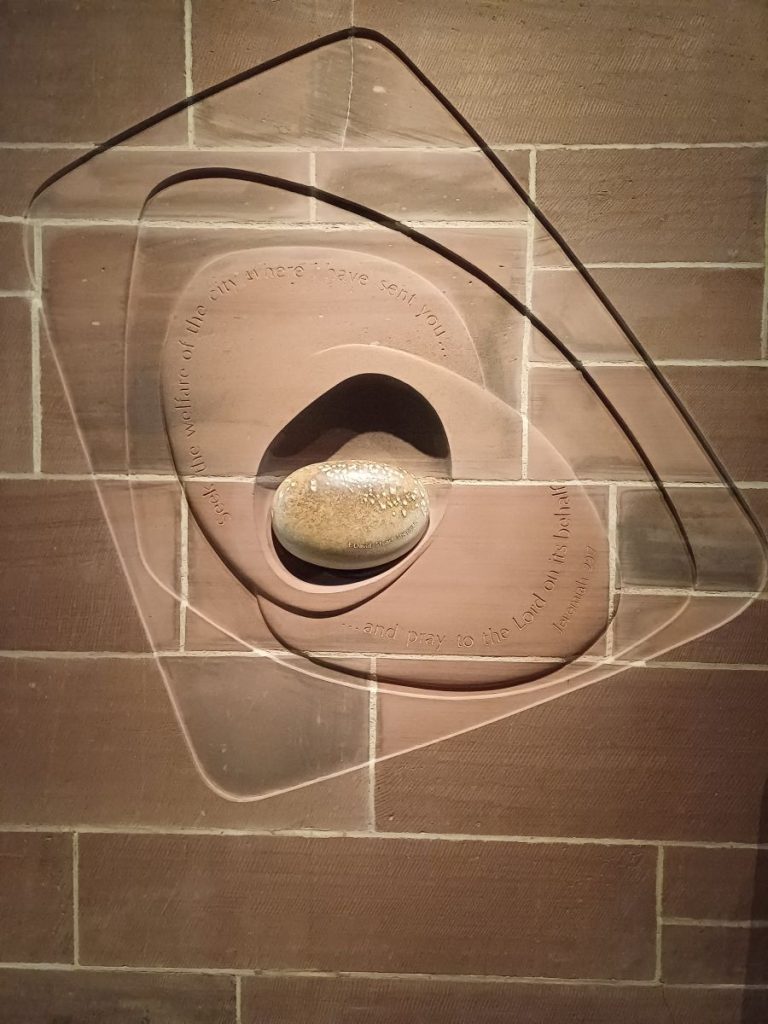
The memorial to the Anglican bishop of Liverpool David Sheppard is sited in one of the walls of the cathedral. The text reads “Seek the welfare of the city where I have sent you… … and pray to the Lord on its behalf (Jeremiah 29:7)”. That rather aptly describes the work of a priest, (especially if you substitute the word parish for city).
Reflections
The combination of these three church buildings has been an interesting experience. There seems to be a much stronger emphasis on contemporary visual arts than I am used to. The church buildings appear to be places where the best art, sculpture and architecture is placed for the glory of God. The art is celebrated and used, to a greater or lesser degree, to tell the story of the building and the story of faith.
As buildings with a primary purpose of housing Christian worship, there is a very mixed approach to talking about Jesus. This definitely offers scope for more work later in this project. I suspect that, in past generations, we could assume that everyone has been taught the basics of Christianity in school, even if they are not from actively church-going families. Now, we cannot be so sure. The C of E school my kids go to make RE a compulsory part of the curriculum up to 16 and also have a comprehensive programme of collective worship. Non-C of E schools do not come close to this – and they vastly outnumber the C of E ones. We cannot expect that most young people have any idea about the fundamentals of Christianity beyond the vaguest of memories of primary school nativity plays (with or without lobsters c.f. Love Actually). This is probably true for most middle-aged people as well.
There seems to be a separation of history and faith in all the interpretation. From the point of view of a priest, this seems bizarre. You cannot understand the history if you do not appreciate the life of faith that has provoked the building and maintenance of church buildings. Everything about the building tells something about what was important to the generation of Christians that built it, or to the subsequent generations who changed it. Church communities leave their mark on church buildings but they do so in ways that they may not realise at the time, and which quickly become opaque to those visiting the buildings without the benefit of eye-witness guides.
I suspect that most visitors to our church buildings do not come with an expectation of a spiritual experience or learning about the life of faith. We have the choice of whether to offer a solely factual historical account ‘who’, ‘what’, or whether to delve into the ‘why’ and stretch their imaginations a little.
